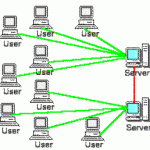The article Communicating in Synchronous Text-Based Virtual Communities by L.D. Roberts, L.M. Smith and C.M. Pollock, published in “Communicating in Synchronous Text-Based Virtual Communities” (Encyclopedia of Virtual Communities and Technologies (2006): 42-48) describes how users interact socially within the text-based computer-mediated environment of the Internet Relay Chat (IRC). It begins with a short introduction to what IRC is and what its main features are. The core part of the article presents the findings and commentaries of a study about the kinds of social interaction IRC users engage in. Data was collected via interviews.
IRC provides social interaction through synchronous text-based computer-mediated communication between multiple users. By synchronous communication it is understood interaction that takes place in real time, between users that are online at the same time.
Although recent chat room software allows users to choose the type of communication they want to engage in, the most common means of communication in IRC is the typed one, referred to as “chatting”. Voice and video conferencing divulge too much from the user’s identity.
Typed communication uses different graphical features as paralinguistic, which means that the written text is infused with non-verbal elements that are used to covey emotion. Thus oral qualities are given to a typed message using:
– ellipsis (suspension points)
– multiple punctuation
– spelling peculiarities
– emoticons (e.g. smiley)
– capitalization for emphasis
One of the most interesting things that happens to a persons who chats using IRC is telepresence – “the degree to which the individual feels present in IRC, rather than in his/her immediate physical environment” (p. 44)
Degrees of telepresence:
– experiencing little telepresence
– maintaining a dual awareness of the self at the keyboard and their nick (identity) on IRC (or switching the focus between the two)
– no distinction made between the off-line self and on-line nick
– being more aware of the nick than the physical self while using IRC
Online communication (using IRC) vs. off-line communication
– IRC never lacks members present in the chat room; no need to find a communication partner
– social barriers are eliminated in IRC interaction, thus making it easier to approach people and start a conversation
– most IRC channels are topic based, so it’s easy to find people with similar interests
– IRC focuses only on typed communication; people who lack nonverbal communication skills don’t need to worry
– disabilities that affect communication (such as deafness, speech problems etc) are not of concern when using IRC
Positive disinhibited behaviour
– users experience positive social interaction with others
– users form friendships (online and off-line)
Negative disinhibited behaviour
– impacted negatively on users online or off-line lives
– examples: lying, deception, harassment, threats
Benefits of IRC
– allows users to engage in multiple conversations simultaneously
– communication can be public or private
– facilitates social interaction
Own Reflections
Telepresence is not a characteristic of chat rooms only. It can happen to any passionate user of computers. It happened to me too when I was ‘young and restless’ and played strategy games (such as Warcraft) for hours and hours, skipping meals and forgetting about the outside world.
Thai Chat Box is a chat room that is unique in the sense that it’s a “family friendly chat room” where people “from around the world can chat in safety.” It is made very clear in an introductory post “10 Quick Ways to Get Yourself Banned” that Thai Chat Box is not a “dating service” and “discussions of the bar scene in Thailand” are not allowed.


